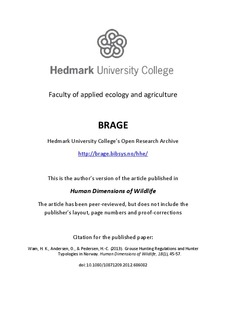Grouse hunting regulations and hunter typologies in Norway
Journal article, Peer reviewed
Permanent lenke
http://hdl.handle.net/11250/134662Utgivelsesdato
2013Metadata
Vis full innførselSamlinger
Originalversjon
Wam, H. K., Andersen, O., & Pedersen, H.-C. (2013). Grouse Hunting Regulations and Hunter Typologies in Norway. Human Dimensions of Wildlife, 18(1), 45-57. doi: 10.1080/10871209.2012.686082 10.1080/10871209.2012.686082Sammendrag
Sustainable game management relies on satisfied hunters. Satisfaction determinants are seldom uniform across all hunters and may therefore be difficult to accommodate. Latent class analysis (LCA) is a probabilistic model-based approach to categorizing hunter typologies (by, e.g., their attitudes and preferences). We applied LCA to large-scale survey data relating to grouse hunting regulations in Norway (3,293 respondents). We identified three typologies with regard to importance of bag size (“The Experience Seeker” 43%, “The Bag Oriented” 32% and “The Northern Traditionalist” 25%) and crowding tolerance (“The Semi-tolerant Mainstream” 85%, “The Laissez Faire” 11%, and “The Passionate Crowd-avoiding” 4%). We could not find a single set of typologies that conformed to both aspects, which suggests that studies of this kind are more likely to be successful if target-specific. We conclude that knowledge of typologies is valuable for tailoring local hunting regulations, provided their actual distribution is identified at the appropriate scale.
Beskrivelse
This is the postprint version of the article. The published article can be found at http://www.tandfonline.com/doi/full/10.1080/10871209.2012.686082#.UvIOc7TeORk
